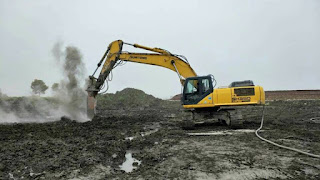In situ bioremediation of oil contaminated soil
In today’s world, oil has become the main energy sources, large amounts of oil and its processed products enter the soil during transportation, manufacturing, and related procedures, resulting in oil contaminated soil, bring harm to the whole biosphere, is one of the most important environmental problems in the world. Bioremediation, as a potentially efficient and low-cost technology, is gaining more and more attention in the study of petroleum pollution.
The main types of bioremediation are the following:
(1)In-situ bioremediation
Refers to the contaminated soil without handling or conveying in situ bioremediation of pollution treatment, the recovery process mainly depends on its natural polluted microbial degradation
ability and create appropriate degradation conditions.
Related processing techniques are:
1.Pump/Treatment
2.Bioventing
3.Percolation
4.Diffusing
(2)Ex-situBioremediation
Refers to the bioremediation of contaminated soil in elsewhere, which transportation are limited, and more emphasis on controlling and creating a more optimized environment for degradation.
In situ bioremediation has two main characteristics, mainly lies in the simple process, low cost, small ecological risk. But in situ bioremediation has more stringent prerequisite requirements, including little or no toxic intermediates, contaminants do not contain biologically inhibitory components and so on, the it is very harsh terms, but because of tight land resources and capital costs, in situ bioremediation is the preferred method for diesel contaminated soil remediation. Composite microorganisms and plants will play a role in the diesel contaminated soil remediation process, the role of plant which is directly absorbe generated pollutants or generate microbial enzyme to promote bio chemical reaction; while the role of microorganisms is to change the content of various pollutants in soil. There is a major problem with the use of pollutants, that is, non indigenous microorganisms are difficult to maintain high activity in the local soil. When plants and microorganisms are combined, microorganisms can act as mycorrhizal fungi on the roots of plants, and metabolize some of the pollutants that cannot be metabolized through their own unique metabolic ways. At present, the main research status of in situ bioremediation is focused on three aspects: microbial activity, biodegradation of petroleum hydrocarbons, and selection with high biodegradability. In situ bioremediation still has limitations insurmountable, mainly reflected in: highly demanding for soil types, the impact of environmental factors, process vulnerable affected by small changes in concentration, end treating immature.

PARFECT provides in situ soil mixing equipment, and injecting liquid or solid stabilization agent into the soil while mixing the soil, which can be applied to diesel contaminated soil remediation and foundation consolidation project.
评论
发表评论